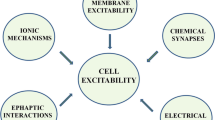Abstract.
The occurrence, pharmacological properties and function of α2-autoreceptors were studied in hippocampal slices, occipito-parietal cortex slices, segments of heart atria and segments of the vas deferens of wildtype (WT) mice and mice in which the α2 A/D-adrenoceptor gene had been disrupted (α2 A/DKO). Tissues were preincubated with [3H]-noradrenaline and then superfused and stimulated electrically. Stimulation periods for brain slices consisted either of 1 pulse or of 2–64 pulses delivered at 1-s intervals; stimulation periods for peripheral tissues consisted either of 1 POP (pseudo-one-pulse; brief burst of 20 pulses/50 Hz) or of 2–4 POPs delivered at 1-s intervals. Single pulses or POPs were used to study the effect of medetomidine and its interaction with antagonists. One or more pulses or POPs per stimulation period were used to study α2-autoinhibition.
Medetomidine decreased the evoked overflow of tritium in WT tissues. In α2 A/DKO tissues, the inhibition was slightly (peripheral tissues) or greatly (brain slices) attenuated but not abolished. Phentolamine, rauwolscine, spiroxatrine, 2-(2,6-dimethoxyphenoxyethyl)aminomethyl-1,4-benzodioxane (WB 4101), tolazoline and prazosin antagonized the effect of medetomidine in all tissues. Their pKd values against medetomidine were compared with pKd values at prototypical α2 binding sites by means of a correlation analysis. For WT brain and atrial autoreceptors, the correlations indicated an α2D pharmacology, whereas for WT vas deferens autoreceptors they favoured an α2B pharmacology. In the KO tissues, any correlation with α2D was lost, and the non-α2 A/D-autoreceptors displayed α2B or α2C pharmacology. When 2 or more pulses or POPs were applied to WT tissues per stimulation period, the pulse number-overflow curve (POP number-overflow curve) was flat, indicating that overflow elicited by p pulses (POPs) was much smaller than p times the overflow elicited by a single pulse (POP); moreover, rauwolscine caused a pulse (POP) number-dependent and, at high pulse (POP) numbers, large increase in evoked tritium overflow. In α2 A/DKO tissues, the pulse (POP) number-overflow curve was much steeper, indicating that overflow elicited by p pulses (POPs) was closer to p times the overflow elicited by a single pulse (POP); moreover, rauwolscine caused no (atria) or only a small increase in overflow, and did so in brain slices only at high pulse numbers (16 and 64).
In conclusion, the predominant α2D pharmacology of the autoreceptors in WT tissues supports the idea that the main mammalian presynaptic α2-autoreceptors belong to the α2 A/D subtype. However, α2 A/D-deficient animals also possess autoreceptors. As expected, these non-α2 A/D-autoreceptors display α2B or α2C pharmacology. In WT animals, α2B- or α2C-autoreceptors or both may coexist with α2 A/D-autoreceptors, at least in peripheral tissues. Little autoinhibition by released noradrenaline in trains of pulses remains when the α2 A/D-adrenoceptor is lacking, again in accord with a predominance of α2 A/D-autoreceptors.
Similar content being viewed by others
Author information
Authors and Affiliations
Additional information
Electronic Publication
Rights and permissions
About this article
Cite this article
Trendelenburg, AU., Hein, L., Gerhard Gaiser, E. et al. Occurrence, pharmacology and function of presynaptic α2-autoreceptors in α2 A/D-adrenoceptor-deficient mice. Naunyn-Schmiedeberg's Arch Pharmacol 360, 540–551 (1999). https://doi.org/10.1007/s002109900093
Received:
Accepted:
Issue Date:
DOI: https://doi.org/10.1007/s002109900093




